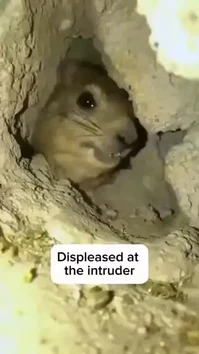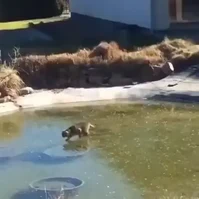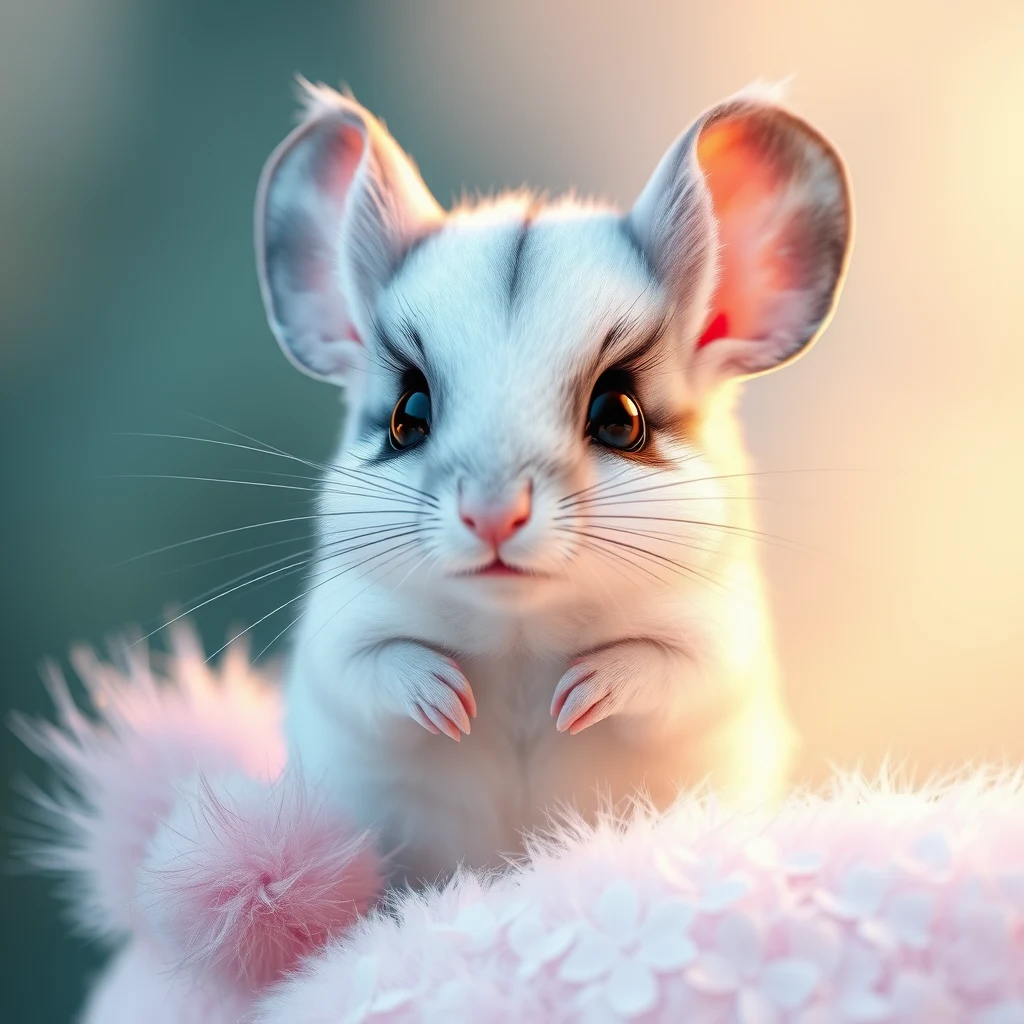- Christmas : hat
- Lv97_Slime : kill that communist and throw him in the trash
- 1
- 13
お水おいしー!🥤🐍💕#コーンスネーク pic.twitter.com/q6KgOehhkj
— ちーちゃん🐶🐰🦎🐹🐸🐍🐠🦞 (@ciiichan_bichon) October 12, 2024
-
FatBastard
: Stop doxxing me

- Nightcrawler : Goomble will be here soon and his comment will say hats and @aevann add shoes
- 23
- 79
Please help add to my collection of elephants wearing clothes. Blankets count if they look like a jumper but pants are better. !animalposters
- 42
- 59
It's a foster. I have commitment issues due to child hood trauma so I can't commit to anything.
- 8
- 56
Name: Antechinus (Antechinus)
Where it lives: Australia
What it eats: Insects, spiders, centipedes and sometimes frogs and small reptiles
Why it's awesome: Antechinuses are little marsupials about the size of gerbils with a bizarre reproductive system: the males have s*x until they die from organ failure.
There are 15 species of Antechinus all with the same deadly mating system. Their breeding season is a frenzied period lasting just two to three weeks. During this time, males give up sleep to have as much s*x as possible, going for up to 14 hours at a time in the hope of passing on their genes. Once the breeding season ends, all the males drop dead.
Males die as a result of stress and exhaustion. During the mating window, testosterone and the stress hormone cortisol surge in their bodies. The increase in testosterone prevents them from processing the cortisol, causing organ failure and death.
Some male antechinuses survive, but this is very rare. "Males stop making sperm before the mating season and their testes disintegrate, so they are not even using energy on that during the mating period," Diana Fisher, a mammal ecologist at the University of Queensland in Australia, said in a statement in 2013. "But they can never reproduce again even if they do live."
During the mating season, sperm is stored in the epididymis and is constantly lost in urine, so they have a very brief window to mate before infertility and death.
The antechinus mass mortality event provides an opportunity — fresh food for the pregnant females and any males that manage to survive the sexfest. Females take the opportunity to cannibalize their own males.
In areas where different species of Antechinus overlap, females may also feast on males from other species. "Each species may benefit from eating dead males of the other," Andrew Baker, an ecologist at the Queensland University of Technology, said in a statement in 2024.
Males from one Antechinus species may feed on those from another if the timing of their breeding seasons allows it. "For the later-breeding species, both sexes may take the opportunity to cannibalize dead males of the earlier-breeding species, to help stack on weight and condition before their own breeding period commences," Baker said, adding that in one case, a male — potentially in the middle of his own mating season — was seen feeding on a "dead comrade" had hair loss indicating stress-induced changes. "He was perhaps destined soon to become somebody else's meal," Baker said.
Gestation in females lasts between 25 and 35 days, after which the undeveloped young move to a pouch on their mother's abdomen to grow for another 50 days. Once the young are independent at about three months, the cycle starts again, with antechinuses reaching sexual maturity at around eight months.
- 1
- 8
bonus
-->i got kicked for 30 mins but came back to say their channel was crappy and my message went through<--
Got kicked, sccidently leftand came back and wanted to test it if it would tell me im timoutted like last live i was in for saying klamidia 2024


- 13
- 11
- 2
- 7
- 3
- 12
Hopefully this is the right video, it gave me no thumbnail to look and see. Thats my device fault tho 
- 11
- 51
The dark, rushing, bracingly cold waters of North Carolina's Watauga River don't make life easy for the conservationists trying to locate rare and endangered Eastern hellbenders.
Earlier this summer, a team of scientists decked out in scuba gear and scoured the riverbed up to 18ft (5.5m) below the surface. Working mainly in the hours around midnight, their work required powerful dive lights and a little animal psychology.
"Hellbenders are difficult to find," says Andy Hill of the conservation organisation MountainTrue, where he is High Country regional director and Watauga riverkeeper, the key protector, watchdog and spokesperson for the Watauga River watershed. "They're perfectly camouflaged. We try to get into the mind of a hellbender – we identify quality habitat and look for clear, cold-running water. We look under every rock and crevice. You train your eye to look for movement – a blinking eye, a flash. You're elated every time you find one."
Every hellbender counts in the mission to save the largest aquatic salamander species in North America. The elusive, little-known freshwater amphibians, which can grow up to 29in (74cm) long, live in rivers in underwater caves or dens formed by boulders. They have broad, flat heads and stocky, flattened bodies that help them blend into rocky stream beds, with short strong limbs and small beady eyes on top of their heads. They're usually grey or brown in colour, with blotchy or mottled skin that helps them to remain camouflaged in rocky riverbeds.
The animal also goes by the nicknames "snot otter" (due to their slimy skin, which secretes mucus to protect them against bacteria and parasites), "devil dog", "grampus". Their skin is wrinkled and loose, especially along the sides of their bodies, which increases the surface area for respiration, as hellbenders can absorb oxygen through their skin – those flappy folds of skin along their torsos look like a cooked lasagne, earning them another nickname: "lasagne lizard". The salamanders are hard to spot, not just because they're good at hiding, but because their numbers are dwindling.
Previously widespread across 15 US states, from southern New York to northern Georgia and from the central Appalachians to Missouri, nearly 80% of hellbenders have been wiped out across their range. Hellbenders are listed as near-threatened by the International Union for Conservation of Nature (IUCN). In some areas, particularly in the Ozarks and the Appalachian regions, they are currently endangered or have gone locally extinct. In North Carolina, hellbenders are a "species of special concern" (a legal designation for wildlife facing significant risks).
Hill's latest surveys for the hellbender in the Watauga River ran for five days in June. Working as part of a crew of 10 scuba-diving scientists from MountainTrue, North Carolina Wildlife Resources Commission, American Rivers and Appalachian State University, the team's task was to find hellbenders and move them out of harm's way, ahead of removing a dam on the river. Shull's Mill Dam is an old gristmill that dates back to the 19th Century, previously used to grind farmers' grain.
In total, the team removed nine hellbenders: four adult females, four adult males and one immature (larval stage) hellbender. The hellbenders were placed in temporary wooden and soft meshed enclosures, which were then anchored to the riverbed in a new site 14 miles (23km) downstream, a high-quality habitat created by the removal of another dam, Ward's Mill, in 2021. They remained in enclosures for 48 hours before release, to recover from the stress of relocation and acclimatise to their new surroundings. This helps survival rates, according to Hill. The hellbenders have been tagged and will now be monitored to see if they stay and breed in the new location, or move elsewhere.
It's not the first time hellbenders have been relocated in the US for works such as bridge replacements or road projects. But this was the first time hellbenders were moved from one dam-removal site to a spot where a dam had already been removed, says Hill. Rescuing as many adult hellbenders as possible is important, explains Hill, as long-living breeding adults contribute many generations to the population.
Nearly 41% of amphibian species around the world, including salamanders, frogs, newts and toads, are currently at risk of extinction, making the group the most threatened class of vertebrates. Habitat loss affects 93% of those threatened amphibians.
"There is no recorded decline as drastic as the one experienced by amphibians," says Amaël Borzée, co-chair of the amphibian specialist group at the IUCN's Species Survival Commission. "Declines are not localised – they're truly global. The main threat is habitat loss and degradation – preventing further habitat degradation would be vital."
Climate change is also proving to be more of a risk than previously thought, says Borzéem, as are the impacts of extractive industries such as mining. "While most species can face threats once at a time, the synergy of threats touching amphibians is deadly to numerous species."
In July, the amphibian specialist group called for urgent global action to prevent further losses. Like insects or unpopular species like vultures, amphibians "only extremely rarely get the attention they need", says Borzée. "There are very few protected areas focusing on an amphibian population, despite the number of threatened species. Amphibians have permeable skin and often live in both aquatic and terrestrial habitats, so they can be incredibly sensitive to environmental changes, such as pollution."
Watch this short NPR video about relocating and conserving them in Ohio:
- 48
- 107
Born May 11, 1992, Bobi lived exactly 31 years, 165 days, according to Guinness. He passed away Oct. 21 in Conqueiros, the Portuguese village where he spend his entire life.
"Despite outliving every dog in history, his 11,478 days on earth would never be enough for those who loved him," veterinarian Karen Becker, who met Bobi several times, wrote on Facebook.
Guinness World Records verified Bobi's exact age—30 years, 266 days at the time—on Feb. 1. That set the records for both oldest living dog and oldest dog ever. The previous oldest dog ever, Australian cattle dog Bluey, lived to be 29 years and 5 months old.
That record had stood since 1939.
It's a bit of a miracle Bobi even made it to 1 year old, let alone 31. Bobi was one of four male Rafeiro do Alentejo puppies, but Costa's parents had decided they couldn't care for any additional dogs. They collected the puppies to dispose of them—a normal practice at the time, according to Costa—though they forgot Bobi.
He'd hid in the outbuilding at the Costa home in Conqueiros, and his mother dog had returned again and again to care for him. Costa and his brothers found Bobi but kept his presence a secret at first. Of course, their parents eventually found out, but Bobi was too old to be thrown away.
"I confess that when they found out that we already knew, they screamed a lot and punished us, but it was worth it and for a good reason!" Costa told Guinness.
That was 31 years ago, when Costa was 8. Bobi then enjoyed a quiet life in the village. He was never been put on a leash or chain, and his diet consisted of what his humans eat. (This was OK for Bobi, but it's probably not good for your dog.)
As he aged, Bobi didn't roam around the nearby forest or farmland as much as he used to, according to Guinness. His eyesight suffered, too, and he took longer rests, including after meals or in front of the fire.
"We have regular [vet] appointments with him and the exams have always shown that he is doing well for his advanced age," Costa says.
The average lifespan for a Rafeiro do Alentejo—a livestock guardian dog native to Portugal—is 12 to 14 years, according to the American Kennel Club. But Bobi's mother, Gira, lived to 18, and another dog belonging to the Costas, Chicote, made it to 22.
Guiness consulted the Veterinary Medical Service of the Municipality of Leiria to verify Bobi's age, and they confirmed his birthdate: May 11, 1992.
"Bobi is special because looking at him is like remembering the people who were part of our family and unfortunately are no longer here, like my father, my brother, or my grandparents who have already left this world," Costa told Guinness. "Bobi represents those generations."
Rest in peace, buddy.
What a good boy.
- Sphereserf3232 : Who?
- 33
- 52
It's been a week since I've seen him. Heading home tomorrow and going to give him all the love.











 Smartest crab?
Smartest crab? 





.webp?h=8)
 BRUM
BRUM 




























 him up
him up




 EMERGENCY
EMERGENCY 

















 — then females eat their corpses
— then females eat their corpses 















 Rescue...Snored For Hours. Zzzzzzzzzzz.
Rescue...Snored For Hours. Zzzzzzzzzzz.



































 Meet the "lasagna lizard"
Meet the "lasagna lizard"  AKA the snot otter
AKA the snot otter  the US's ancient and unique salamander
the US's ancient and unique salamander 







 The World's Oldest Dog Ever, Bobi, Dies at 31
The World's Oldest Dog Ever, Bobi, Dies at 31 





















